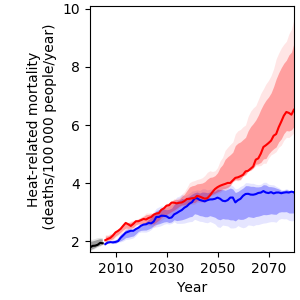Tanzania: Human health
Climate change threatens the health and sanitation sector through more frequent incidences of heatwaves, floods, droughts and storms. Among the key health challenges in Tanzania are morbidity and mortality through respiratory diseases, tuberculosis, HIV / AIDS, vector-borne diseases such as malaria, and impacts of extreme weather events (e.g. flooding) including injury and mortality as well as related waterborne diseases such as diarrhoea. Many of these health challenges are expected to become more severe under climate change, which will likely impact food security and water supply, thereby increasing the risk of malnutrition, hunger and death by famine. Studies identified climate change as a primary driver of malnutrition in Tanzania, in addition to demographic change and poverty [33]. According to the Tanzanian Demographic and Health Survey 2015 / 2016, 34 % of all children under five years of age suffer from stunting and 14 % from underweight [34]. Furthermore, climate change is likely to extend the transmission periods and alter the geographic range of vector-borne diseases, for example, due to rising temperatures and changes in precipitation. Malaria, for instance, has been a common disease in Tanzania’s low-lying rural areas, but is becoming increasingly prevalent in the previously malaria-free highlands due to climatic changes [35]. Although malaria admission and death rates have been decreasing in recent years, Tanzania has the third largest population at risk of this disease in Africa, with 90 % of the population living in malaria areas [36]. Coastal regions bordering the Indian Ocean and Lake Victoria exhibit particularly high vulnerability to malaria as well as to dengue [37], [38].
Exposure to heatwaves
Rising temperatures will result in more frequent heatwaves in Tanzania, leading to increased heat-related mortality. Under RCP6.0, the population affected by at least one heatwave per year is projected to increase from 2 % in 2000 to 19 % in 2080 (Figure 18).

Heat-related mortality
Furthermore, under RCP6.0, heat-related mortality will likely increase from 1.8 to 6.5 deaths per 100 000 people per year, which translates to an increase by a factor of more than three towards the end of the century compared to year 2000 levels, provided that no adaptation to hotter conditions will take place (Figure 19). Under RCP2.6, heat-related mortality is projected to increase to about 3.5 deaths per 100 000 people per year in 2080.

References
[33] Inter-Agency Research and Analysis Network, “Overcoming the Challenges of Undernutrition in Tanzania Through 2021,” London, UK, 2017.
[34] Ministry of Health, “Demographic and Health Survey and Malaria Indicator Survey,” Dar es Salaam, Tanzania, 2015.
[35] L. E. G. Mboera, B. K. Mayala, E. J. Kweka, and H. D. Mazigo, “Impact of Climate Change on Human Health and Health Systems in Tanzania: A Review,” Tanzan. J. Health Res., vol. 13, no. 5, pp. 1–23, 2012.
[36] MalariaSpot, “Malaria in Tanzania,” 2016. Online available: https://malariaspot.org / en / eduspot / malaria-in-tanzania [Accessed: 13-Dec-2019].
[37] D. de Savigny, C. Mayombana, E. Mwageni, H. Masanja, A. Minhaj, Y. Mkilindi, C. Mbuya, H. Kasale, and G. Reid, “Care-Seeking Patterns for Fatal Malaria in Tanzania,” Malar. J., vol. 3, pp. 1–15, 2004.
[38] C. N. Mweya, S. I. Kimera, G. Stanley, G. Misinzo, and L. E. G. Mboera, “Climate change influences potential distribution of infected Aedes aegypti co-occurrence with dengue epidemics risk areas in Tanzania,” PLoS One, vol. 11, no. 9, 2016.


